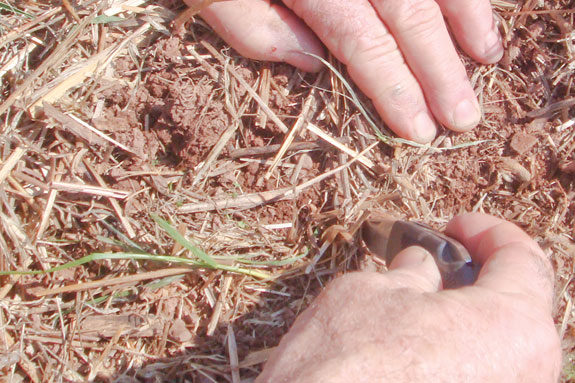No-till seeding has many apparent advantages over conventional seeding. Soil erosion concerns are probably No. 1, as there are few crop fields more highly erodible than a worked field of an alfalfa or grass seeding.
Another advantage of no-till seeding is significant savings in fuel requirements and labor/time savings. Finally, the ability to conserve soil moisture levels during late summer no-till seedings can greatly improve establishment success.
The Golden Rule of successful small seedings is: “Pay attention to the smallest detail.” All factors of sound agronomics must be considered when no-tilling small-seeded forages – from planning existing vegetation control programs to soil fertility requirements to species selection to site conditions. Be prepared and plan ahead.
Having proper, well-maintained no-till equipment is part of a sound agronomic program. There are many different types of no-till drills on today’s market. The intent of this equipment is to correctly meter the proper amount of seed and place it, in firm contact with the soil, at a uniform depth of 1/4- to 3/8-inch. To do this properly, the seed openers must be able to “cut” surface residue and not disturb the soil surface too much.
The use of double disc-type seed openers is preferable for shallow seedings of small-seeded crops. To operate correctly, these double discs need to be properly maintained and replaced when worn.
A business card can be used to measure the contact area between the two discs. If pictured as a clock, the two discs should be in contact at the part of discs that is beneath the soil surface, 7 to 4 on a clock face.
As the discs wear, they separate and seed will be placed on the soil surface instead of below it. Simply dropping seed behind the opening discs and hoping for a successful stand is not acceptable.

Press wheels on drills are important to successful establishment. Seed must be firmed up to the soil to permit moisture absorption to initiate germination. On many drills the press wheel also controls seeding depth.
Drill calibration is critical. Most drills come with suggested seed type settings posted on seeding charts. These are good guides, but too often seed sizes will vary or the exact type of seed is not listed. Most university guides and commercial seed producers have recommended seeding rates.
Proper calibration of equipment is still needed, especially as equipment is used and parts wear. One simple method to calibrate a drill is to load the drill with seed, attach some type of collection bag on each drop tube, and then travel 100 feet.
Collect the total seed and weigh this seed on a gram scale. Divide this gram weight by 454 to determine pounds of seed collected in the 100 feet. Multiply this amount by 43,560 and then divide the value by the total of the drill width in feet multiplied by 100 (the distance traveled during seed collection). The resulting number is the seeding rate in pounds per acre.
Seeding depth is critical. Most seeding failures are the result of seeding too deep. Seeds should be planted three to five times the seed size. For most small-seeded crops this is 1/4 to 3/8 of an inch. Producers will need to frequently get off the tractor to check proper drill set-ups. You should occasionally find a few seeds on top of the soil. If not, then you are seeding too deep.
Soil fertility is critical to seedling development. Small seedlings have small roots and proper nutrients must be readily available in the upper soil surface level. Be sure to take soil samples and make soil fertility adjustments in advance of seeding. A top-dress of 20 to 30 pounds of nitrogen per acre at planting will result in seedlings getting off to a good start.
Proper time of year and soil conditions must be considered. All plant species have specific requirements for germination and development. Cool-season grasses or alfalfa can germinate at soil temperatures in the 50s, while warm- season species such as sorghum sudangrass need significantly warmer soil temperatures. Proper soil conditions are needed for proper opener penetration and seed slit closure. Use patience at seeding to ensure success.
Finally, post-seeding management is critical to a successful stand establishment. Agronomists refer to the seeding year of a forage crop. They do not mean three months or six months. Post-seeding management practices such as weed and insect control, cutting or grazing intervals or height, can severely impact young crops and affect long-term stand success.
Successful no-till seedings of small-seeded crops are possible. Plan ahead and be prepared for optimum seeding opportunities. Make sure your equipment is properly maintained and have your soil fertility and existing vegetation program planned and scheduled. FG
PHOTOS
PHOTO 1: The intent of no-till drills is to correctly meter the proper amount of seed and place it, in firm contact with the soil, at a uniform depth.
Photo 2: Seeding depth is critical. Producers will need to frequently get off the tractor to check proper drill set-ups. Photos courtesy of Paul H. Craig.









